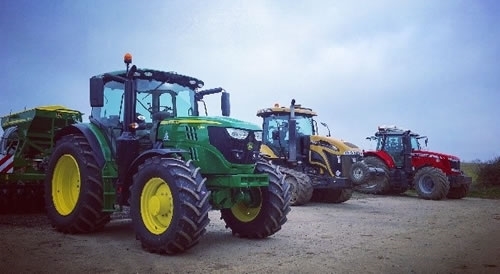By Amelia Woolford, Allerton Project Development Officer
It seems clear that farmers, as some of the custodians of the countryside, need to take care of their soil, as without it, we can’t farm. We know that soils are important for our crops and therefore food security, as well as the wider environmental benefits supported by good soil health. By its very nature, without this essential component, we would not be able to grow food, provide wildlife habitats, prevent flooding or have clean water.
£5.3 billion is spent on agriculture annually and 25% of this goes on soil degradation costs (Defra, 2012). There is no one single strategy to tackle this impact. It is therefore important to consider your objectives and management strategy, from sowing methods and dates, pest protection and establishment along with crop rotation, which advances in agricultural technology will help with.
At the Allerton project in Leicestershire, numerous studies are taking place to investigate the impact of cover cropping and cultivation methods on soil resilience. The Project in partnership with the National Farmers Union (NFU) and LEAF hosted a stimulating soils event, sponsored by Dale Drills and Kings. A range of experts attended to discuss the latest industry research and how farmers can and are leading the way to achieve healthy soils for the benefit of the environment, crop yields and consumers.

The soils day was attended by nearly 50 farmers, NFU members, industry advisers, researchers and policy makers and was chaired by Mike Hambly (NFU, National Combinable Crops Board).
Timeliness is everything
We kick-started the day with a research review from Dr. Felicity Crotty (the Allerton Project soil scientist), who highlighted the innovative 3-year SIP project and the benefits that cover cropping can bring. These include, but are not limited to, nutrient retention, ecosystem provisioning, increased organic matter, reduced soil erosion, livestock forage and weed control. We also learnt that earthworm weight can be greater per hectare underground than the livestock above ground which graze it!
 Following this, Ron Stobart of NIAB evaluated the impact of cover cropping at a landscape scale, he was quick to point out that; ‘Patience and careful management in cover cropping is required! Benefits are not always immediate and there are challenges along the way.’
Following this, Ron Stobart of NIAB evaluated the impact of cover cropping at a landscape scale, he was quick to point out that; ‘Patience and careful management in cover cropping is required! Benefits are not always immediate and there are challenges along the way.’
There are many risk factors within these systems which require careful management. Greenbridge pests and diseases, rotational conflict, weeds such as volunteer cover crops in following cash crop and destruction methods must be thought out.
Mike Hambly concluded this session; ‘Like with anything, in farming, timeliness is everything’.
Key aims of cover cropping
Chris Baylis, LEAF demonstration farmer and head of farming for Sutton Settled Estates gave a farmer’s view on the practicalities of cover cropping and direct drilling. In his system, there are 6 key aims; utilise cultural control of weeds, pests and diseases, maintain the soil nutrient balance, spread financial risk, increase biodiversity, maintain soil structure and spread workload to utilise on farm resources. It is worth noting that success isn’t always what you see.
This can be put into context with green area and rooting depth, although it is important to retain soil cover, we also want the underground benefits of cover cropping, so balancing starter fertilizer is crucial. Chris also commented that drainage must be managed, as there are challenges with cover cropping on heavy land.
Our final speaker, Professor Jonathan Leake discussed the importance of mycorrhizal fungi and what they can deliver. In 2 million hectares of wheat in the UK there is mycorrhizal hyphae that would stretch from the earth to the sun 26,000 times or over 500 times to Pluto! Cover cropping can be used as a nurse crop for mycorrhiza and its presence will encourage phosphorus capture and nutrient use efficiency. It will also contribute to improved soil structure and greater organic matter. However, it must be said that soil structure cannot be attributed to one sole component but a combination of management strategies.

The grand tour
A soils day wouldn’t be complete without a farm tour, looking at the Allerton Project’s research in action and of course, a look at some shiny kit. In the field discussions on future challenges facing soil management ensued. Conversation centred around soil management practices across the diverse soil types in the UK. Sited on the farmyard were examples of machinery and a quick drilling demo- this included Dale Drills, John Deere, Sumo, and Claydon, some of which are used by the Allerton project to direct drill seeds into the untilled land.
Changes to cultivation techniques can help to build a resilient soil, that can withstand more frequent and exceptional weather events such as flash flooding and drought. This will be vital as we go forward so that we can continue to farm our food efficiently while caring for the environment.
Phil Jarvis, Head of Farming at the Allerton project stated; ‘I want to improve my soil health and profitability, but patience is key, there's no right or wrong, it's what fits with the system’.
Dr Felicity Crotty pointed out the 3 types of earthworms found in UK soils, whilst Dr Alastair Leake compared soils from farm fields within 200metres of each other, permanent pasture through to arable.
 The day brought some insightful debate. These systems are not easy on heavy land but are important for the diversity across all farming systems. We must not ignore the massive impact the approaches discussed can help increase soil resilience. This can help reduce the £1.5 billion cost to the economy of soil degradation. The real question is how to reward farmers for delivering resilient soils, but establishment methods and success is measured by an individual farm basis, there is no one size fits all solution.
The day brought some insightful debate. These systems are not easy on heavy land but are important for the diversity across all farming systems. We must not ignore the massive impact the approaches discussed can help increase soil resilience. This can help reduce the £1.5 billion cost to the economy of soil degradation. The real question is how to reward farmers for delivering resilient soils, but establishment methods and success is measured by an individual farm basis, there is no one size fits all solution.
This event at the Allerton Project has shown how food production works in harmony, as well as enhancing the farmed environment. With a UK population of 60 million people, set to rise to 70 million in the next decade, food and farming needed to be at the heart of Government and that the A in Defra should once again stand for agriculture. Although we strive for farming to be profitable it is more than being a businessman, it's about being environmentally aware.
Future questions to consider
- Are black oats better, in cover crops, than others?
- Were cover crops direct drilled? Soil disturbance stimulates biological activity including weed germination.
- Is there a role for grazing cover crops in arable systems?
Event feedback
‘Over the winter I have been to several conferences and talks but this event stood out as it was the best in terms of speakers, topics chosen, and practical demonstrations of what could be achieved. Excellent!’
‘We thought we knew it all 15 years ago, now we know nothing as we open new horizons.’
 Free weekly newsletter
Free weekly newsletter
Stay updated and get all the latest GWCT news, event invites and offers delivered straight to your inbox each week.
Sign up FREE to the Weekly GWCT Newsletter >